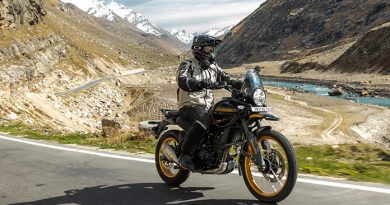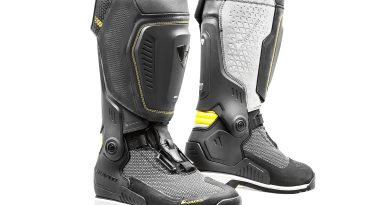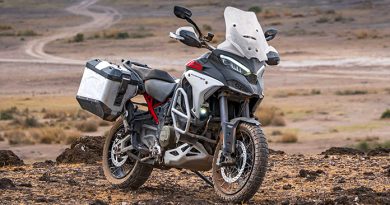2021 Yamaha Tracer 9 GT | Road Test Review
New styling on the Tracer 9 GT includes full LED lighting and extended fairing lowers that provide additional weather protection for the rider’s legs. (Photos by Kevin Wing)
Some motorcycles are fantastic right out of the gate. Others take a little time to find their way. They’re diamonds in the rough, requiring an update or two to chip away the rough edges and realize their full potential. The 2021 Yamaha Tracer 9 GT is one such bike.
Eight years ago, I traveled to San Francisco for the press launch of the all-new Yamaha FZ-09. It was a naked sportbike with an exciting, brash engine, an 847cc inline-Triple with a crossplane crankshaft that imbued it with gobs of character and torque. And at just $7,990, it was a steal. But there were downsides, like fueling issues, mediocre suspension and brakes, and a rock-hard seat.
The Tracer 9 GT is a fully equipped sport-tourer. For 2021 and 2022 model years, it’s available in Redline (shown above) and Liquid Metal.
A year after the FZ-09 debuted, Yamaha released a sport-touring version called the FJ-09, which was equipped with an upper fairing, a windscreen, upgraded rider and passenger seats, revised suspension, and optional saddlebags. At $10,490, it was a bargain too, and certainly more practical than the FZ, but the FJ-09 still suffered from a herky-jerky throttle and suspension and brakes that fell well short of the engine’s capabilities.
Nonetheless, both the FZ-09 and FJ-09 sold well. The FZ-09 was updated for 2017, and its major shortcomings were addressed. When Yamaha decided to standardize model names globally, it became the MT-09, and for 2021 it was updated again with a larger 890cc Triple, a revised chassis, and new electronics.
The FJ-09 got its first major update for 2019, and it was offered in two variants, also with new names: the standard Tracer 900 and the premium, touring-ready Tracer 900 GT. Both models featured new styling, smoother throttle response, a longer swingarm for more stability, and a larger, one-hand-adjustable windscreen. The GT also had upgraded suspension, a TFT color display, cruise control, heated grips, and a quickshifter. All that goodness ratcheted up the price to $12,999 for the GT, but it was still a good value.
Larger 890cc Triple makes more power.
We quickly grew fond of the Tracer 900 GT, which was agile, responsive, and well-suited for solo touring. Following the press launch, I spent a few days exploring backroads in Oregon and California. After I put nearly 2,000 miles on the bike, former Managing Editor Jenny Smith installed Yamaha’s accessory comfort seat and touring windscreen. Then she embarked on a 7-day, 5,000-mile endurance test that included the Three Flags Classic, a rally with stops in Mexico, Canada, and the U.S. We were reluctant to give back the keys.
Like an adventure bike, the Tracer 9 GT has an upright seating position with generous legroom.
But 2021 is when the Tracer 9 GT has come of age. With a new name and now offered only in the GT version, it’s more capable, more comfortable, and more fully featured. It got the larger 890cc Triple from the MT-09, which is more powerful, more fuel efficient, and saves nearly 4 pounds of weight. On Jett Tuning’s dyno, the Tracer 9 GT made 108 horsepower at10,000 rpm and 63 lb-ft of torque at 7,200 rpm at the rear wheel. That’s a gain of 5 horsepower and 6 lb-ft of torque over the Tracer 900 GT we tested last year. During this test, we averaged 48.7 mpg, up from 44 mpg on the Tracer 900 GT. Fuel capacity increased slightly to 5 gallons on the Tracer 9 GT, and our estimated range was 243 miles, up from 211 miles on the previous model.
One-hand-adjustable windscreen and larger handguards provide good wind protection, and heated grips are standard.
Although throttle response issues were resolved during the previous update, the Tracer 9 gets the latest version of Yamaha’s Y-CCT (Yamaha Chip Controlled Throttle) throttle-by-wire, which uses an APSG (Accelerator Position Sensor Grip) for a more refined feel. A 15% increase in crankshaft inertia further smooths out on/off throttle transitions. On the road, there is a direct connection between the right grip and the rear wheel without any harshness.
Both the windscreen and seat are adjustable for height, and the handlebar and footpegs are adjustable for reach.
Yamaha’s D-Mode, which adjusts power and throttle response, now has four preset modes: 1, 2, and 3 offer full power with progressively milder response, while 4 reduces power and has the softest response. Mode 1 corresponds to what would be called “sport” mode on many motorcycles, which is often overly abrupt, but not so on the Tracer 9 GT. Throttle response is immediate without being too aggressive. As the dyno chart shows, torque is consistent through the rev range, so there’s always grunt available when you need it.
The Tracer has always been an agile bike, but the upgraded suspension and lighter wheels make it even better.
Wrapped around the engine is a new aluminum frame made using a controlled-fill diecast process that reduces mass and increases lateral rigidity by 50%. A 1.2-inch lower headstock and mounting the engine more vertically helps centralize mass. A new aluminum swingarm is mounted within the frame for more rigidity, and a new steel subframe increases load capacity and allows an accessory top trunk to be mounted along with the larger 30-liter saddlebags.
Larger saddlebags will hold a full-face helmet in each side, and they can be left unlocked for easy access.
The saddlebags are large enough to hold a full-face helmet in each side. The bags can be left unlocked for convenient access, locked for security, or removed to carry into a hotel room or to lighten the load for apex strafing. The lock barrels can be a little fiddly (which has long been an issue with Yamaha luggage), but with practice they work just fine.
New KYB semi-active suspension electronically adjusts damping based on real-time conditions.
Another upgrade for the Tracer 9 GT is semi-active suspension. The KYB Actimatic Damping System (KADS) uses input from a 6-axis IMU, the ECU, a hydraulic control unit, a stroke sensor on the fork, and an angular position sensor on the rear shock to adjust damping based on real-time conditions. The system electronically adjusts compression and rebound damping in the fork and rebound damping in the rear shock, and there are two modes, A-1 (sport) and A-2 (comfort). Spring preload must be adjusted manually using a tool for the fork (it’s in the toolkit) and a remote knob for the shock.
The Tracer 9 GT is ideally suited for solo sport-touring, but it has a comfortable passenger seat and can be fitted with an accessory top trunk.
With 5.1/5.3 inches of front/rear suspension travel, the Tracer 9 GT has plenty of available stroke to absorb bumps, seams, potholes, and other pavement irregularities. By adapting to changing conditions, the KADS suspension delivers a supple, compliant ride and it quickly firms up as needed to prevent excessive chassis pitch under braking and acceleration. The Tracer 9 GT feels more sure-footed in corners than its predecessor, with excellent grip from its Bridgestone Battlax T32 GT sport-touring tires. Agility has gotten a boost from new 10-spoke aluminum wheels made using Yamaha’s new “spinforging” process, which saves 1.5 pounds of unsprung weight.
Full LED lighting includes headlights, position lights, and cornering lights.
In addition to its new semi-active suspension, the Tracer 9 GT has a more comprehensive suite of IMU-based electronic rider aids derived from the YZF-R1 sportbike, including traction control, slide control, lift control, and ABS, with intervention adapted to lean angle and other inputs. The electronics have multiple modes, and the only system that can’t be turned off is ABS. The IMU also provides input for new LED cornering lights, which illuminate the insides of cornering when lean angle exceeds 7 degrees.
The Tracer 9 GT has an upright seating position, more like an adventure bike than the more committed ergonomics on many sport-tourers. Being able to sit up straight with no weight on the rider’s wrists, relaxed shoulders, and ample legroom makes it enjoyable to pile on the miles, and that’s what a sport-tourer is all about. The one-hand-adjustable windscreen and handguards provide good wind protection too.
A new dual TFT display provides a wealth of info, and what is shown in the grid on the right side is customizable.
Comfort and convenience features include cruise control, heated grips, and a quickshifter. In addition to upshifts, the quickshifter now provides clutchless downshifts with an auto-blipper. And the heated grips now offer 10 levels of adjustment. The Tracer also has full LED lighting, a 12-volt outlet behind the instrument panel, and a centerstand.
Yamaha has given the Tracer a unique dual-panel TFT display, with each screen measuring 3.5 inches. The speedometer, tachometer, gear indicator, and other functions are on the left panel. The right panel has a grid of four smaller displays that can be customized to show the rider’s preferred info, even if the information is also shown on the left panel. The mostly white-on-black text is crisp and clear, but some of the text is small. The TFT panels have a glossy surface that reflects sunlight and can make the screens appear too dim (brightness is not adjustable). Depending on the position of the sun, sometimes all I could see was the reflection of my riding jacket.
The Tracer is equipped with a centerstand for easier chain maintenance and loading/unloading the saddlebags.
Yamaha upgraded the rider’s seat with higher-quality cover material and added color-matched stitching. The dual-height rider’s seat can be set at 31.9 or 32.5 inches. To suit riders of different body types or preferences, the bars and footpegs can be adjusted. Rotating the bar-riser clamps allows the handlebar to be moved up 4mm and forward 9mm, and the footpeg brackets can be moved up 14mm and back 4mm. The passenger seat is now thicker and wider, and there’s a new integrated, one-piece grab handle.
The Tracer 9 GT’s many upgrades have raised the price to $14,899, which is $1,900 more than last year’s Tracer 900 GT. For those who are cross-shopping, BMW’s F 900 XR (with Select and Premium Packages but no saddlebags) is $15,045 and Kawasaki’s Versys 1000 SE LT+ costs $18,199. Even though the Tracer is more expensive than its predecessor, it’s priced lower than its closest competitors and no important features were left off the spec sheet.
New “spinforged” wheels save 1.5 pounds of unsprung weight. They also have larger-diameter axles and are fitted with Bridgestone Battlax T32 GT sport-touring tires.
Over the past several years we’ve put thousands and thousands of miles on the FJ-09, the Tracer 900 GT, and now the Tracer 9 GT. We were immediately won over by its exciting Triple and its playful maneuverability. Yamaha kept at it with a steady regimen of improvements and refinement, and the platform got better and better.
This year Yamaha hit the bullseye, and the Tracer 9 GT earned Rider‘s 2021 Motorcycle of the Year award. We’re more reluctant than ever to give the keys back.
The Tracer’s new saddlebags feature a floating stay damper system to absorb mass transfer during cornering to keep the chassis stable.
2021 Yamaha Tracer 9 GT Specs
Base Price: $14,899
Warranty: 1 yr., unltd. miles
Website: yamahamotorsports.com
ENGINE
Type: Liquid-cooled, transverse inline-Triple, DOHC w/ 4 valves per cyl.
Displacement: 890cc
Bore x Stroke: 78.0mm x 62.1mm
Compression Ratio: 11.5:1
Valve Insp. Interval: 26,600 miles
Fuel Delivery: EFI w/ YCC-T & 41mm throttle bodies x 3
Lubrication System: Wet sump, 3.4 qt. cap.
Transmission: 6-speed, cable-actuated wet slip/assist clutch
Final Drive: O-ring chain
CHASSIS
Frame: Cast aluminum w/ engine as stressed member & cast aluminum swingarm
Wheelbase: 59.1 in.
Rake/Trail: 25 degrees/4.3 in.
Seat Height: 31.9/32.5 in.
Suspension, Front: 41mm inverted fork, electronically adj. rebound & compression, manually adj. preload, 5.1 in. travel
Rear: Single shock, electronically adj. rebound, manually adj. preload (remote), 5.4 in. travel
Brakes, Front: Dual 298mm discs w/ 4-piston radial calipers & ABS
Rear: Single 245mm disc w/ 2-piston caliper & ABS
Wheels, Front: Cast, 3.50 x 17 in.
Rear: Cast, 5.50 x 17 in.
Tires, Front: 120/70-ZR17
Rear: 180/55-ZR17
Wet Weight: 503 lbs. (including saddlebags)
Load Capacity: 407 lbs.
GVWR: 910 lbs.
PERFORMANCE
Horsepower: 108 @ 10,000 rpm (rear-wheel dyno)
Torque: 63 lb-ft @ 7,200 rpm (rear-wheel dyno)
Fuel Capacity: 5.0 gals.
Fuel Consumption: 48.7 mpg
Estimated Range: 243 miles
The post 2021 Yamaha Tracer 9 GT | Road Test Review first appeared on Rider Magazine.




